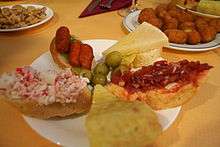Spanish cuisine
Although less famous than its culinary neighbours to the east or north, Spanish cuisine is one of the great cuisines of the Mediterranean.
Understand

As Spain itself is composed of many regions with strong local identities, it's no surprise that its cuisine is very variable too. Like other Mediterranean cuisines, it has influences from Roman times, but unlike most of the northern rim of the Mediterranean, the Iberian peninsula also was part of the Islamic world for centuries (introducing ingredients such as rice). Afterwards Spain was one of the very first European powers to establish colonies in the Americas and elsewhere in the world, therefore many exotic products reached Spain before the rest of Europe.
Compared to most other countries, people in Spain tend to eat late. Lunch is eaten at 14:00 or later in the afternoon, in former times this was followed by a siesta but this is not as commons as it used to be (many businesses still close for an hour or more in the afternoon). Dinner is had at 20:00 or later; a few Spaniards even have dinner at midnight. Between lunch and dinner restaurants are often closed and you may need to go to a fast food place, café or tapa bar for a light meal if you're hungry then. The exception is restaurants at more touristy destinations such as on the Costa del Sol but even there they might have a limited menu and the restaurant is often nearly empty.
One specialty of Spanish cuisine is tapas, small bites of meat, seafood, cheese or vegetables that are traditionally eaten as bar snacks. Some common tapas are olives, jamón serrano, manchego cheese, sardines and chorizo but almost everything the Spanish cuisine has to offer is available as tapas (depending on where in the country you are), so a visit to a tapas bar is a fantastic way to sample Spanish food. Whereas the drinks are the main thing in bars in most parts of the world and snacks are only a decoration, in a tapas bar it's the other way around. You can actually combine tapas to have a full meal.
Ingredients
Spanish cuisine includes a wide variety of vegetables, meat and seafood. Dishes are light and not overly spicy.
Dishes

- Paella — originally from Valencia, there's an infinite number of different paella variants. It's a rice dish with different vegetables, often seafood (fish, shrimp, mussels, calamari...) and/or meat (often chicken or rabbit). In restaurants, you often need to be more than one person ordering a pan of paella although at some places they serve paella to lone patrons as well.
- Jamón serrano and jamón iberico — cured ham served in thin slices. Iberico is a finer and more expensive variant.
- Chorizo — spicy sausage
- Patatas bravas — diced and fried potatoes served with a spicy sauce
- Gazpacho — cold tomato soup
- Cod Fritters — typical tapa from Catalonia.
Desserts
- Churros — long deep-fried donuts, often eaten for breakfast and with chocolate dip (churros con chocolate)
- Crema catalana — a traditional recipe, similar to the French crème brûlée, where the top is caramelised by using a hot iron.
Beverages
.jpg)
- Wine — Spain is one of the world's great wine countries, La Rioja and Penedès being the most famous wine-growing regions. Other alcoholic beverages made of grapes include the Spanish champagne cava, sherry (fortified wine from the region around Jerez de la Frontera) and Sangria, a drink with wine and orange (or some other) juice.
- Coffee — the coffee and café culture is similar to the one in other Mediterranean countries.
- Horchata (Valencian: Orxata) is a Valencian speciality made from sweetened tiger nuts.
- Fruit juices from street vendors are readily available (at least at beach destinations) and very refreshing on hot days (much of the year).
- Beer is also enjoyed by locals and visitors alike. San Miguel, Estrella Damm, CruzCampo, Moritz are the largest beer brands, and can be very affordable in supermarkets, however Spain is witnessing a craft beer revolution in major and minor cities, which is challenging the big players.